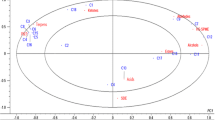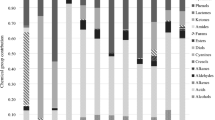Abstract
Nano-sized polyaniline (50–150 nm) has been prepared by polymerization of aniline on the surface of the commercial polyester fiber. A method for determination of adulteration in lemon juice samples was developed. Solid-phase microextraction (SPME) by polyester-polyaniline fiber to extract volatile organic compounds (VOCs) and analysis of gas chromatography (GC) profile were used. The effects of industrial lemon juice (ILJ) percent, organic lemon juice (OLJ) percent, and storage time of lemon juice as tree variable factors on the gas chromatography profile were studied. D-optimal combined design (DOCD) was applied to design the experiments that study the gas chromatography profile. For this purpose, the recorded chromatograms of VOCs were divided into four-time sections (0–5, 5–10, 10–15, and 15–20 min) and the peak number, total peak height, and total peak area in the four divided time sections were analyzed. The results were analyzed, and statistical test of correlation and linear regression was used. Results showed that there is good relation between industrial lemon juice percent, organic lemon juice percent, and storage time and peak characters (peak numbers, total peak height, and total peak area) in the divided time sections of each chromatogram. So, the presented method is a good method to find adulteration in organic lemon juice by gas chromatography profile analysis.






Similar content being viewed by others
References
Ansari R (2006) Application of polyaniline and its composites for adsorption/recovery of chromium(VI) from aqueous solutions. Acta Chim Slov 53:88–94
Bhadra S, Khastgir D (2008) Extrinsic and intrinsic structural change during heat treatment of polyaniline. Polym Degrad Stab 93:1094–1099
Castaldo D (2008) Estimating bergamot juice adulteration of lemon juice by high-performance liquid chromatography (HPLC) analysis of flavanone glycosides. J Agric Food Chem 56:5407–5414
Cooper JC, Hall EAH (1993) Catalytic reduction of benzoquinone at polyaniline and polyaniline/enzyme films. Electroanalysis 5:385–397
Davis WB (1947) Determination of flavanones in citrus fruits. Anal Chem 19(7):476–477
Domenico C, Bruna L, Francesca S, Antonio T, Luigi S, Domenico C (2008) Estimating bergamot juice adulteration of lemon juice by high-performance liquid chromatography (HPLC) analysis of flavanone glycosides. J Agric Food Chem 56:5407–5414
Ehling S, Cole S (2011) Analysis of organic acids in fruit juices by liquid chromatography–mass spectrometry: an enhanced tool for authenticity testing. J Agric Food Chem 59:2229–2234
Fabrizio M, Furlanetto F, Mengoli G, Musiani MM, Paolicci F (1992) Polyaniline-based membranes for gas electrodes. J Electroanal Chem 323:197–212
Heber D (2009) International multidimensional authenticity specification (IMAS) algorithm for detection of commercial pomegranate juice adulteration. J Agric Food Chem 6:2550–2557
Jamin E, Martin F, Santamaria-Fernandez R, Lees M (2005) Detection of exogenous citric acid in fruit juices by stable isotope ratio analysis. J Agric Food Chem 53:5130–5133
Jia MY, Zhang QH, Min DB (1988) Optimization of solid-phase microextraction analysis for headspace flavor compounds of orange juice. J Agric Food Chem 36:2744–2747
Jordan M, Tillman TN, Mucci B, Laencina J (2001) Using HS-SPME to determine the effects of reducing insoluble solids on aromatic composition of orange juice. Lebens Wiss Technol 34:244–250
Kovats E (1958) Gas chromatography characterization of organic compounds. HelV Chim Acta 41:1915–1932
Malik MN, Scora RW, Soost RK (1974) Studies on the origin of the lemon. Hilgardia 42:361–382
Moshonas MG, Shaw PE, Veldhuis MK (1972) Analysis of volatile constituents from Meyer lemon oil. J Agric Food Chem 20:751–752
Nam-Sun K, Dong-Sun L (2004) Headspace solid-phase microextraction for characterization of fragrances of lemon verbena (Aloysia triphylla) by gas chromatography-mass spectrometry. J Sep Sci 27:96–100
Navarro-Pascual-Ahuir M, Lerma-García MJ, Simó-Alfonso EF, Herrero-Martínez JM (2015) Rapid differentiation of commercial juices and blends by using sugar profiles obtained by capillary zone electrophoresis with indirect UV detection. J Agric Food Chem 63:2639–2646
Pirsa S, Alizadeh M, Ghahremannejad N (2016) Application of nano-sized poly N-phenyl pyrrole coated polyester fiber to headspace microextraction of some volatile organic compounds and analysis by gas chromatography. Curr Anal Chem 12:2016
Shaw PE, Wilson CW (1982) Volatile sulfides in headspace gases of fresh and processed citrus juices. J Agric Food Chem 30:685–688
Steffen A, Pawliszyn J (1996) Analysis of flavor volatiles using headspace solid-phase microextraction. J Agric Food Chem 44:2187–2193
Ting YP, Neoh KG, Kang ET, Tan KL (1994) Recovery of gold by electroless precipitation from acid solutions using polyaniline. J Chem Tech Biotech 59:31–37
Widmer WW, Cancalon PF, Nagy S (1992) Methods for determining the adulteration of citrus juices. Trends Food Sci Tech 3:278–286
Yamamoto A (2008) Determination of adulteration in apple juice by HPLC. J Agric Food Chem 16:7302–7304
Yang X, Peppard T (1994) Solid-phase microextraction for flavor analysis. J Agric Food Chem 42:1925–1930
Yang CH, Huang LR, Chih YK, Lin WC, Liu FJ, Wang TL (2007) Molecular assembled self-doped polyaniline copolymer ultra-thin films. Polymer 48:3237–3247
Zhengfang W, Joseph E (2015) Targeted and non-targeted detection of lemon juice adulteration by LC-MS and chemometrics. Food Addit Contam Part A 1–14
Acknowledgements
This work has been supported by grants from the Urmia University Research Council, and the Iran National Science Foundation (INSF) is gratefully acknowledged.
Author information
Authors and Affiliations
Corresponding author
Ethics declarations
Funding
This study was funded by Urmia University, Urmia, Iran.
Conflict of Interest
Sajad Pirsa declares that he has no conflict of interest. Mohammad Alizadeh declares that he has no conflict of interest. Nasrin Faraji declares that she has no conflict of interest.
Ethical Approval
All procedures performed in studies involving human participants were in accordance with the ethical standards of the institutional and/or national research committee and with the 1964 Helsinki Declaration and its later amendments or comparable ethical standards.
This article does not contain any studies with animals performed by any of the authors.
Informed Consent
Not applicable.
Rights and permissions
About this article
Cite this article
Alizadeh, M., Pirsa, S. & Faraji, N. Determination of Lemon Juice Adulteration by Analysis of Gas Chromatography Profile of Volatile Organic Compounds Extracted with Nano-Sized Polyester-Polyaniline Fiber. Food Anal. Methods 10, 2092–2101 (2017). https://doi.org/10.1007/s12161-016-0747-4
Received:
Accepted:
Published:
Issue Date:
DOI: https://doi.org/10.1007/s12161-016-0747-4




